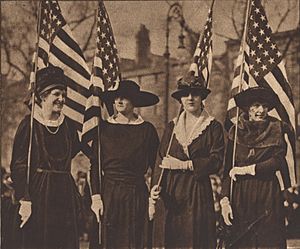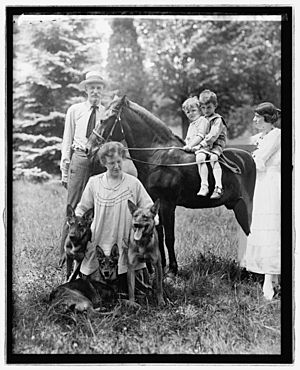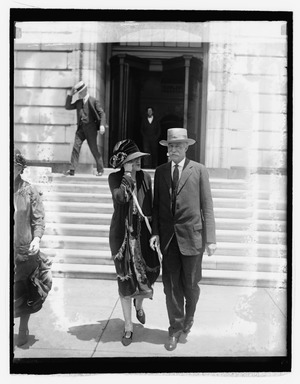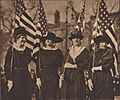Cornelia Bryce Pinchot facts for kids
Quick facts for kids
Cornelia Bryce Pinchot
|
|
|---|---|
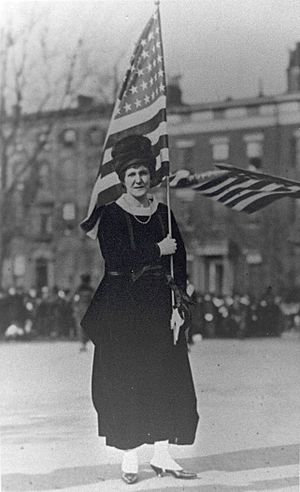 |
|
| Born |
Cornelia Elizabeth Bryce
August 20, 1881 |
| Died | September 9, 1960 |
| Other names | Leila Bryce, Leila Pinchot |
| Occupation | Conservationist, politician, and women's rights activist |
| Spouse(s) | Gifford Pinchot (1865-1946) |
| Parent(s) | Lloyd Stephens Bryce (1851–1917) and Edith (Cooper) Bryce (1854-1916) |
Cornelia Elizabeth Bryce Pinchot (born August 20, 1881 – died September 9, 1960) was an important American woman. She was known as "Leila Pinchot." She worked to protect nature, was involved in politics, and fought for women's rights.
Cornelia played a key role in improving Grey Towers. This was her family's home in Milford, Pennsylvania. It was later given to the U.S. Forest Service and became a National Historic Landmark.
Her great-grandfather was Peter Cooper, who started Cooper Union. Her father, Lloyd Stephens Bryce, was a U.S. Congressman. Cornelia was married to Gifford Pinchot, a famous conservationist and two-time Governor of Pennsylvania. She was also a close friend of U.S. President Theodore Roosevelt.
Cornelia helped start the Committee of 100. She also gave a lot of money to the National Association for the Advancement of Colored People (NAACP). Historians say she was "one of the most politically active first ladies in the history of Pennsylvania."
Contents
Early Life and Family
Cornelia Bryce was born in 1881 in Newport, Rhode Island. She came from a wealthy family. Her parents were Lloyd Stephens Bryce and Edith (Cooper) Bryce. Her great-grandfather was Peter Cooper, who founded Cooper Union. This college offered free education to its students.
Cornelia had two siblings. Her sister, Edith Claire Cram, later started a peace organization during World War II. Her brother, Peter Cooper Bryce, served in the U.S. Cavalry during World War I.
Friends and family called Cornelia "Leila." She went to private schools and traveled in Europe. She was known as an energetic and independent woman. She loved to wear colorful clothes and dyed her hair red. Her friend, Theodore Roosevelt, admired her strong understanding of politics.
In 1887, her father was elected to the U.S. Congress. He was a Democrat. He also owned a literary magazine called North American Review. In 1911, her father became an envoy to the Netherlands. The next year, Cornelia became a strong supporter of the Progressive movement.
Fighting for Change
Cornelia Bryce's political journey began with the women's suffrage movement. This movement fought for women's right to vote. She strongly supported this cause. She also gave a lot of money to the National Association for the Advancement of Colored People (NAACP).
She spoke out for women's rights and better education. She also criticized sweatshops and the use of child labor. Cornelia joined her local school board. She supported Prohibition, which banned alcohol. She was also one of the first important women to ride in an airplane. She encouraged other women to get involved in politics and careers.
On August 15, 1914, Cornelia Bryce married Gifford Pinchot. He was the first chief of the U.S. Forest Service. They met two years earlier during the "Bull Moose campaign." This was an effort by Theodore Roosevelt to start a new political party. Their wedding was at her parents' home in Roslyn, New York. Theodore Roosevelt and other friends were there.
After their marriage, Cornelia and Gifford began spending summers at Grey Towers. This was Gifford's family estate.
Family Life and Grey Towers
In 1915, Cornelia Pinchot gave birth to her only child, Gifford Bryce Pinchot. He was born in New York City. He grew up at Grey Towers. He later became a doctor and served in the U.S. Navy during World War II. He then taught at Yale University and Johns Hopkins University.
Cornelia's parents died within a year of each other.
In 1922, her husband, Gifford Pinchot, won the election to become the 28th Governor of Pennsylvania. Cornelia worked hard for his campaign. She helped get women's votes by getting support from the League of Women Voters and other women's groups.
During his first term, her husband fixed a large state budget problem. He also improved laws for people with disabilities. He worked on rules for electric companies and created a retirement system for state workers. He also helped settle a coal miners' strike.
During this time, Cornelia Pinchot took charge of Grey Towers. She saw that the 43-room stone house and its 102 acres could be a center for her family's conservation and political work. She made many changes to the home to make it "more fitting as a Governor's home."
She changed the breakfast and dining rooms into a large sitting room. She also made the library bigger. She worked with Chester Holmes Aldrich to make the estate's grounds more beautiful. He designed a raised swimming pool area, a playhouse for their son, and a cottage for her husband's political staff. He also improved the views of the countryside.
Political Involvement
Because of Pennsylvania law, her husband could not serve two terms in a row. He ran for the U.S. Senate in 1926 but lost. He then ran again for governor and won in 1930. He became governor during the start of the Great Depression. Many people in Pennsylvania lost their jobs.
Even with challenges, her husband started a pension program for blind Pennsylvanians. He approved rules to punish banks for bad behavior. He created America's first environmental protection agency. He also improved 20,000 miles of rural roads.
Cornelia Pinchot played an active role as First Lady. She helped her husband's plan to improve life for the state's poorest residents. She called this "human conservation."
She continued to be active in politics herself. She supported better labor laws and more educational chances for women. She also wanted workers to form unions. She ran for a seat in the U.S. Congress three times (in 1926, 1928, and 1932) but did not win.
In 1933, she joined young workers on picket lines. These teens were protesting low wages in textile factories. She said she wanted to help them get back to school. In 1934, she tried to become governor after her husband, but she was not successful. She once said, "It is a good game, whether one loses or not."
Her life was not just about politics. In 1929, she traveled with her husband to the South Sea islands. This was an eight-month trip to study birds and shells. They also went deep-sea diving and hiked volcanoes. This trip is known as the Pinchot South Sea Expedition. They collected animal specimens for the U.S. National Museum of Natural History. After returning, Cornelia gave free talks at schools and movie theaters. She showed a documentary about the expedition.
Later Life and Legacy
When the United States entered World War II, Cornelia Pinchot volunteered for the Office of Civilian Defense in Washington, D.C.. She helped organize food and housing services in the city.
In 1946, her husband, Gifford Pinchot, passed away. He was buried at the Milford Cemetery near Grey Towers. Three years later, Cornelia spoke at an event where the Columbia National Forest was renamed the Gifford Pinchot National Forest in his honor.
After the war, she traveled across Europe. She wanted to understand how European leaders were helping children and adults who lost their homes because of the war. In 1949, she was chosen as a delegate to a United Nations conference on conservation.
In 1955, she worked with the U.S. Forestry Service. They created radio shows to teach people about the importance of protecting nature.
Cornelia Bryce Pinchot died on September 9, 1960, at her home in Washington, D.C. She was buried at the Milford Cemetery in Milford, Pennsylvania.
Images for kids


